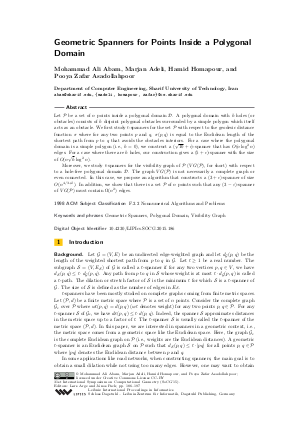Geometric Spanners for Points Inside a Polygonal Domain
Authors Mohammad Ali Abam, Marjan Adeli, Hamid Homapour, Pooya Zafar Asadollahpoor
-
Part of:
Volume:
31st International Symposium on Computational Geometry (SoCG 2015)
Part of: Series: Leibniz International Proceedings in Informatics (LIPIcs)
Part of: Conference: Symposium on Computational Geometry (SoCG) - License:
 Creative Commons Attribution 3.0 Unported license
Creative Commons Attribution 3.0 Unported license
- Publication Date: 2015-06-12
File

PDF
LIPIcs.SOCG.2015.186.pdf
- Filesize: 0.53 MB
- 12 pages
Document Identifiers
Subject Classification
Keywords
- Geometric Spanners
- Polygonal Domain
- Visibility Graph
Metrics
- Access Statistics
-
Total Accesses (updated on a weekly basis)
0Document
0Metadata
Abstract
Let P be a set of n points inside a polygonal domain D. A polygonal domain with h holes (or obstacles) consists of h disjoint polygonal obstacles surrounded by a simple polygon which itself acts as an obstacle. We first study t-spanners for the set P with respect to the geodesic distance function d where for any two points p and q, d(p,q) is equal to the Euclidean length of the shortest path from p to q that avoids the obstacles interiors. For a case where the polygonal domain is a simple polygon (i.e., h=0), we construct a (sqrt(10)+eps)-spanner that has O(n log^2 n) edges where eps is the a given positive real number. For a case where there are h holes, our construction gives a (5+eps)-spanner with the size of O(sqrt(h) n log^2 n).
Moreover, we study t-spanners for the visibility graph of P (VG(P), for short) with respect to a hole-free polygonal domain D. The graph VG(P) is not necessarily a complete graph or even connected. In this case, we propose an algorithm that constructs a (3+eps)-spanner of size almost O(n^{4/3}). In addition, we show that there is a set P of n points such that any (3-eps)-spanner of VG(P) must contain almost n^2 edges.
Cite As Get BibTex
Mohammad Ali Abam, Marjan Adeli, Hamid Homapour, and Pooya Zafar Asadollahpoor. Geometric Spanners for Points Inside a Polygonal Domain. In 31st International Symposium on Computational Geometry (SoCG 2015). Leibniz International Proceedings in Informatics (LIPIcs), Volume 34, pp. 186-197, Schloss Dagstuhl – Leibniz-Zentrum für Informatik (2015)
https://doi.org/10.4230/LIPIcs.SOCG.2015.186
BibTex
@InProceedings{abam_et_al:LIPIcs.SOCG.2015.186,
author = {Abam, Mohammad Ali and Adeli, Marjan and Homapour, Hamid and Asadollahpoor, Pooya Zafar},
title = {{Geometric Spanners for Points Inside a Polygonal Domain}},
booktitle = {31st International Symposium on Computational Geometry (SoCG 2015)},
pages = {186--197},
series = {Leibniz International Proceedings in Informatics (LIPIcs)},
ISBN = {978-3-939897-83-5},
ISSN = {1868-8969},
year = {2015},
volume = {34},
editor = {Arge, Lars and Pach, J\'{a}nos},
publisher = {Schloss Dagstuhl -- Leibniz-Zentrum f{\"u}r Informatik},
address = {Dagstuhl, Germany},
URL = {https://drops.dagstuhl.de/entities/document/10.4230/LIPIcs.SOCG.2015.186},
URN = {urn:nbn:de:0030-drops-51378},
doi = {10.4230/LIPIcs.SOCG.2015.186},
annote = {Keywords: Geometric Spanners, Polygonal Domain, Visibility Graph}
}
Author Details
References
-
Mohammad Ali Abam, Paz Carmi, Mohammad Farshi, and Michiel Smid. On the power of the semi-separated pair decomposition. Computational Geometry, 46(6):631-639, 2013.

-
Mohammad Ali Abam, Mark De Berg, Mohammad Farshi, and Joachim Gudmundsson. Region-fault tolerant geometric spanners. Discrete & Computational Geometry, 41(4):556-582, 2009.

-
Mohammad Ali Abam, Mark De Berg, Mohammad Farshi, Joachim Gudmundsson, and Michiel Smid. Geometric spanners for weighted point sets. Algorithmica, 61(1):207-225, 2011.

-
Mohammad Ali Abam and Sariel Har-Peled. New constructions of sspds and their applications. Computational Geometry, 45(5):200-214, 2012.

-
Pankaj K Agarwal and Micha Sharir. Applications of a new space-partitioning technique. Discrete & Computational Geometry, 9(1):11-38, 1993.

-
Noga Alon, Paul Seymour, and Robin Thomas. Planar separators. SIAM Journal on Discrete Mathematics, 7(2):184-193, 1994.

-
Ingo Althöfer, Gautam Das, David Dobkin, Deborah Joseph, and José Soares. On sparse spanners of weighted graphs. Discrete & Computational Geometry, 9(1):81-100, 1993.

-
Prosenjit Bose, Jurek Czyzowicz, Evangelos Kranakis, Danny Krizanc, and Anil Maheshwari. Polygon cutting: Revisited. In Proceedings of Japanese Conference on Discrete & Computational Geometry (JCDCG'98), volume 1763 of LNCS, pages 81-92. Springer, 1998.

-
Paul B Callahan and S Rao Kosaraju. A decomposition of multidimensional point sets with applications to k-nearest-neighbors and n-body potential fields. Journal of the ACM, 42(1):67-90, 1995.

-
Kenneth L Clarkson, Herbert Edelsbrunner, Leonidas J Guibas, Micha Sharir, and Emo Welzl. Combinatorial complexity bounds for arrangements of curves and spheres. Discrete & Computational Geometry, 5(1):99-160, 1990.

-
Mark de Berg, Otfried Cheong, Marc van Kreveld, and Mark Overmars. Computational Geometry: Algorithms and Applications. Springer-Verlag, 2008.

-
Sariel Har-Peled and Manor Mendel. Fast construction of nets in low-dimensional metrics and their applications. SIAM Journal on Computing, 35(5):1148-1184, 2006.

-
Giri Narasimhan and Michiel Smid. Geometric spanner networks. Cambridge University Press, 2007.

-
Kunal Talwar. Bypassing the embedding: algorithms for low dimensional metrics. In Proceedings of Annual ACM symposium on Theory of computing, pages 281-290, 2004.

-
Kasturi R Varadarajan. A divide-and-conquer algorithm for min-cost perfect matching in the plane. In Proceedings of Annual Symposium on Foundations of Computer Science, pages 320-331, 1998.

